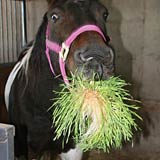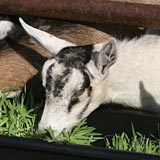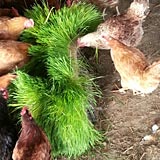- Home
- About
- Contact
- Receive our newsletter
- 1.800.201.3414
Livestock and Horses Questions
Since hydroponic fodder requires breaking away from traditional feeding methods, many folks have concerns about the effects on their animals. If you find yourself in the same situation, take some time to ease those concerns by exploring this section of FAQs.
1) How long does it take livestock to adapt to the fodder diet?
Fodder is something you want to wean your animals onto over time. It should take about 7 to 10 days for your animals to adequately adapt to the fodder.
2) Have horse owners reported a decrease in the need for concentrates or grain while using fodder?
Yes. Fodder is a grain and supplement replacement. It will also reduce the amount of roughage required, but fodder is meant to be a supplement to hay and pasture.
3) Will milk production increase?
Yes. Due to the increased digestibility of fodder, less energy is required to digest it, resulting in more energy available for milk production.
4) I've never fed barley hay to any horses. How do I know that barley fodder is good for them?
Barley is a wonderful, naturally balanced seed in regards to protein, energy and fat. More to the point, we tested it. Forage reports on a number of seeds from our trials are available. If you would like more information or to see a forage report, please contact us, or download the PDF from the specific feed page.
5) How much fodder is needed per day for a producing dairy cow and how much more protein is in fodder percentage-wise?
A producing dairy cow will need about 2% of their live body weight of fodder per day with 1% roughage. Fodder is meant to be a supplement and cannot replace all hay. When it comes to the percentage of increase in protein, it depends on the type of fodder and the type of feed we are relating it to.
6) Will an older horse with bad teeth or almost no teeth be able to eat this?
Fodder is not terribly hard to chew. It should be fine, but if you notice them struggling, cut the fodder into smaller sections.
7) Can I certify the pork and/or beef as organic if I only feed fodder?
That is a very tricky question. In the last several years organic certification has undergone some major changes. Organic certification and regulations come from the federal government and are under the jurisdiction of the National Organic Program. From a feeding standpoint, as long as the seed is organic the animals can be certified organic as well. For more information on organics and the National Organic Program, view the information provided by the Agricultural Marketing Service on the USDA's website.
8) How do you determine how much to feed animals, like horses?
The rule of thumb for feeding fodder is between 2 and 3% of the animal's live body weight per day with 1% roughage. Roughage is only required for ruminants and horses. Fodder can be a full-feed option for poultry and hogs.
9) Would you be able to recommend the type of fodder to use depending on the animal?
That is a tricky question because there are a lot of variables that go into the answer. It largely depends on the type of animal, what you have available, where you're located, what the animal's purpose is in life, their size and what they're currently being fed. If you're looking to start a conversation regarding this, contact us so we can further help you decide.







